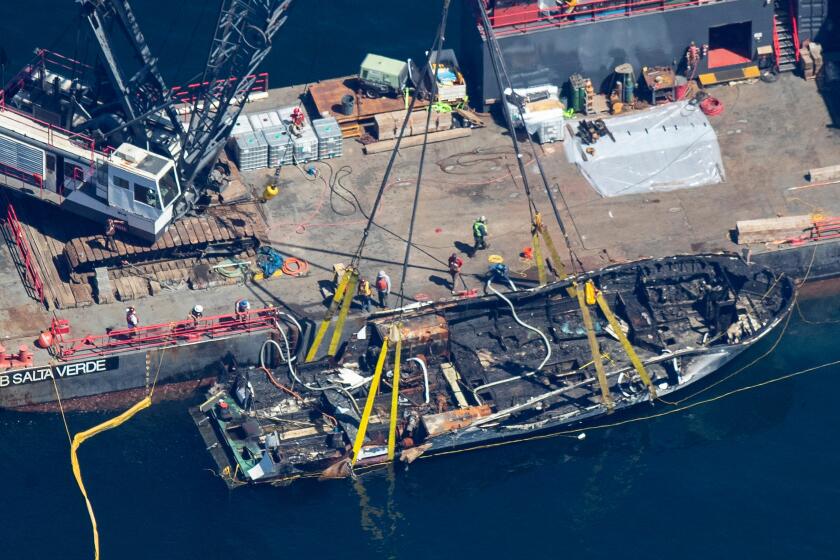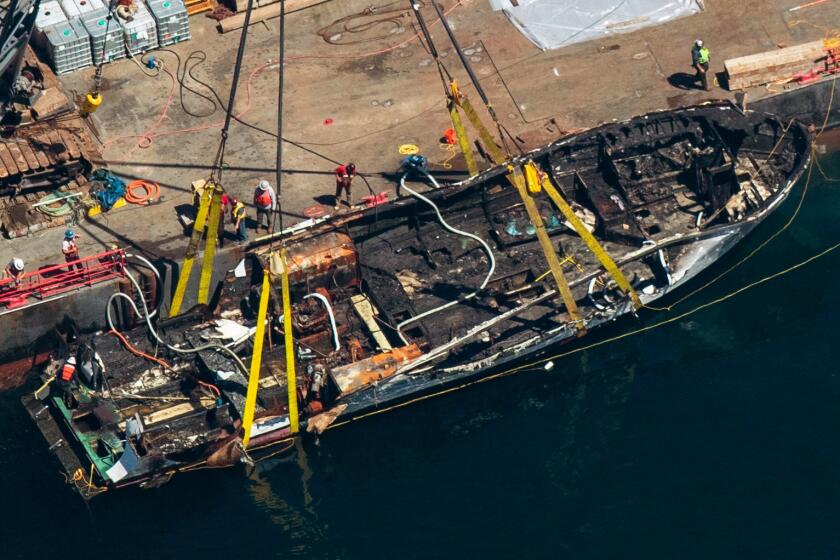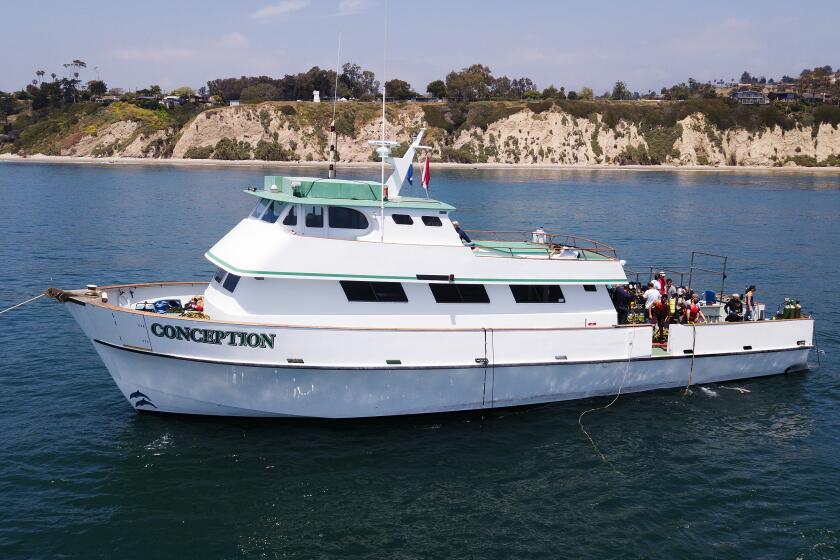California boat fire: Conception wasn’t built to charge dozens of phones, batteries and cameras. Did this cause the blaze?

- Share via
SANTA BARBARA — When the Conception first hit the water in the early 1980s, the personal electronics revolution was decades away.
Divers who boarded the 75-foot boat for excursions to the Channel Islands brought film cameras. There were no smartphones to plug in or the array of other electronic devices now used to take underwater photos.
But when the vessel set off decades later on its fateful Labor Day weekend voyage, those on board needed power — a lot of it. And they plugged their equipment into a series of outlets concealed in the back of foam-filled, L-shaped benches in the ship’s galley.
Those outlets are now the focus of an intense investigation as federal officials try to determine the cause of the worst maritime disaster in modern California history, a fire that swept through the dive boat and killed 34 people.
The Conception was raised from the depths of Platts Harbor and is now at the Port Hueneme naval facility, where the Bureau of Alcohol, Tobacco, Firearms and Explosives national incident team of leading fire experts are examining the power, fuel and electrical systems, federal officials said.
A commercial diving boat caught fire near the shoreline of Santa Cruz Island, Calif., early Monday. Many aboard the boat were believed to be sleeping below deck when the fire broke out in the pre-dawn hours.
As the investigation continues, the U.S. Coast Guard took the unprecedented step of recommending that owners of passenger vessels immediately urge crews to “reduce potential fire hazards and consider limiting the unsupervised charging of lithium-ion batteries and extensive use of power strips and extension cords.”
Divers and others in the boat world said the electrical systems of boats such as the Conception have been put to the test in recent years as the number of electronics brought on board has increased.
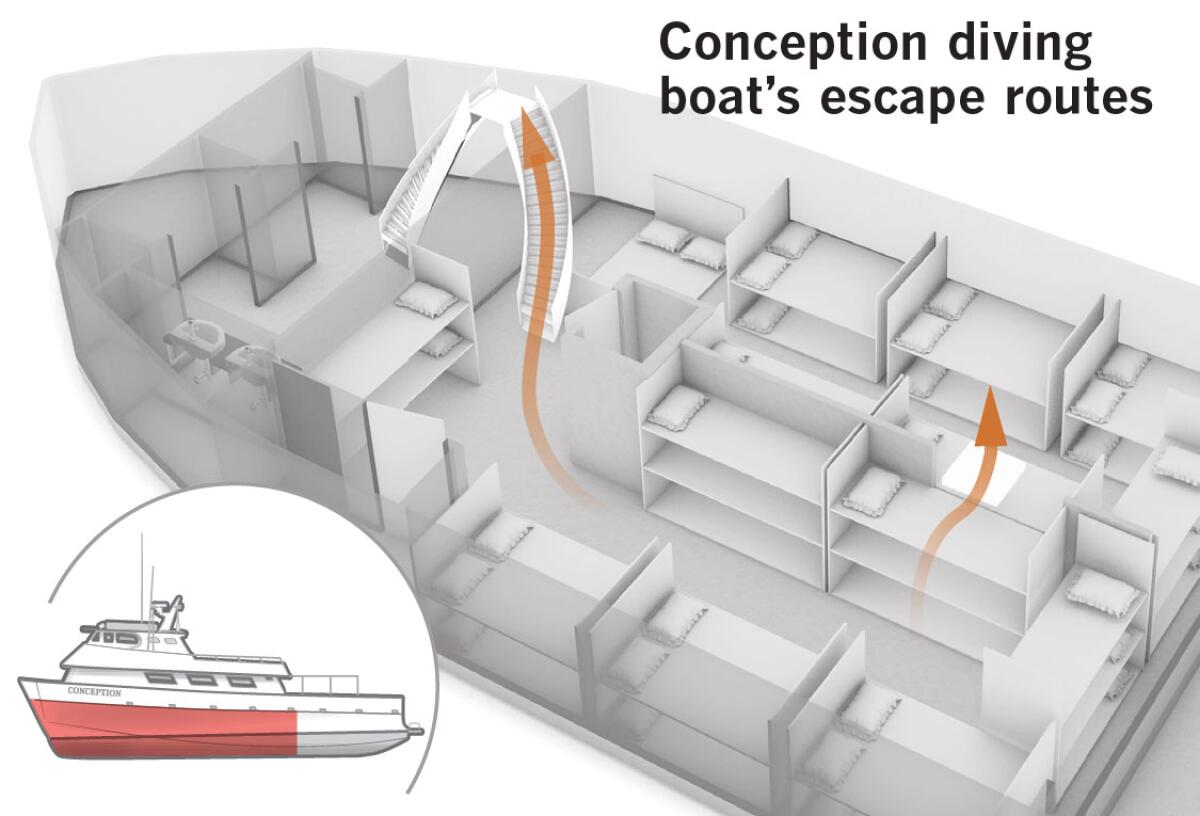
Competing for limited plug space are batteries for strobe lights, digital cameras and underwater light rigs, video camera power packs, GoPro chargers and lithium-ion batteries for cellphones and tablets.
“People have rechargeable everything these days,” said veteran diver Ben Wolfe, a retired Los Angeles County Fire Department captain who dived off the Conception two weeks before its fiery demise. “I had a battery like a TV camera battery that powered my underwater scooter plugged in each night.”
Preliminary investigations have suggested the fire did not start in the engine room, and there are growing signs the origin was in the galley area. On the morning of the fire, one crew member told a rescuer he thought the fire started with electronic devices charging in the galley.
The 34 people who lost their lives in the Conception boat fire included a teenager as young as 17 and adults in their 60s, the Santa Barbara sheriff said.
One of the crew members, Ryan Sims, has filed a lawsuit against the Conception’s owners, alleging Truth Aquatics Inc., Worldwide Diving Adventures and boat owner Glen Fritzler failed to properly train crew members, give adequate safety or medical equipment and provide safety rules.
Sims said in court documents he was awakened by loud noises to discover the already-raging fire. He jumped from the top deck, where he had been sleeping, and broke his leg, before joining four other crew members in a dinghy they took to a nearby boat to call for help.
Some of the crew returned to the burning Conception, but the boat was engulfed in flames and no one else on board, including one additional crew member, was found.
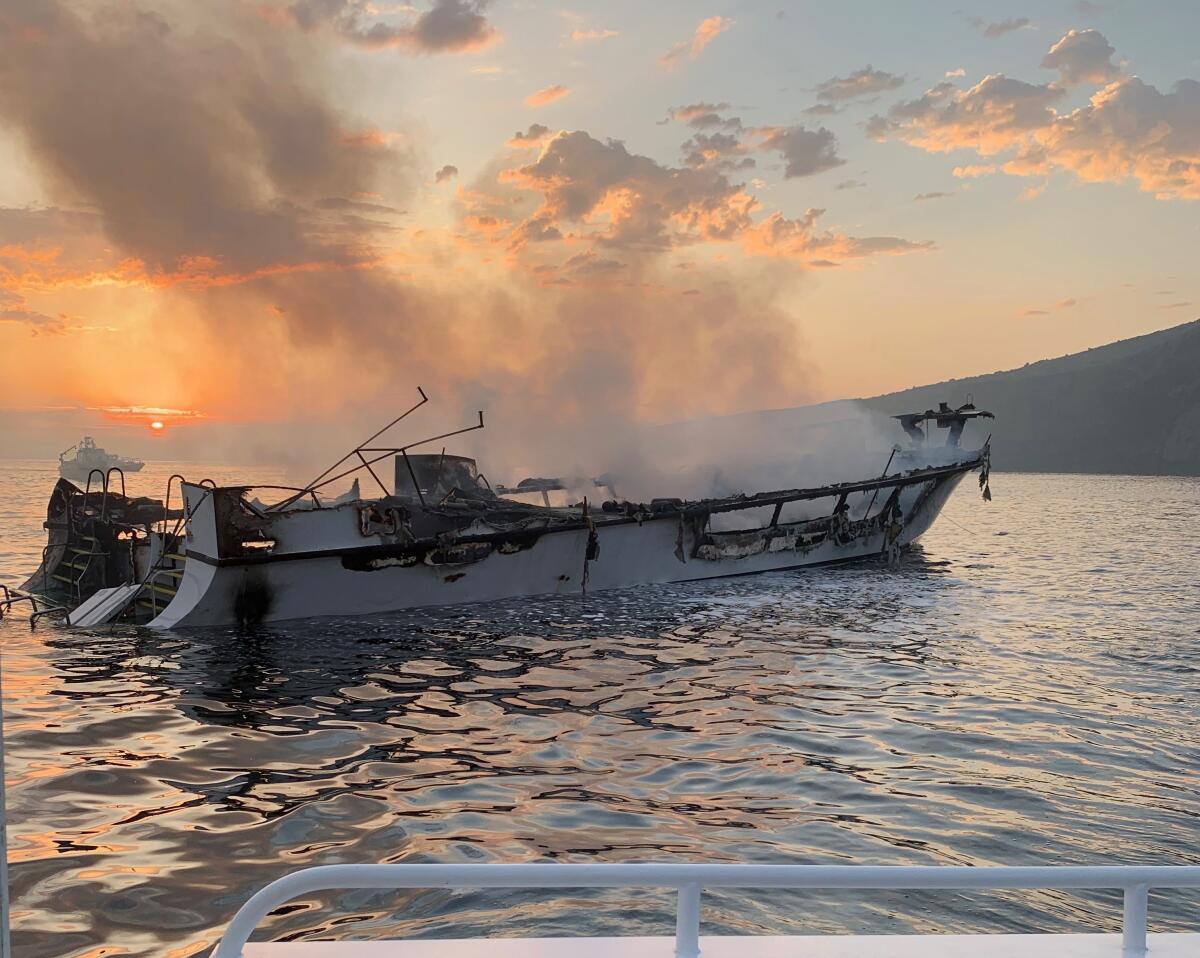
Statistics gathered by insurers and industry watchdogs show that about 55% of shipboard fires in smaller vessels are related to electrical systems. Given the boat had an electric galley and no propane or gasoline, investigators will look at the electrical systems and appliances and their interaction with combustibles, said John McDevitt, a former assistant fire chief, marine surveyor and chairman of the National Fire Protection Assn.
“The environment and salty air plays havoc with the electrical system,” he said. “Electricity is challenging on a boat. With all those charging stations running through an old circuit, it is probably electrical.”
The Conception had passed U.S. Coast Guard inspection before the fire, and the electrical system met federal guidelines.
But experts said frayed, loose or improperly connected wiring behind the walls could have ignited a fire. The volume of device batteries being charged could also have overloaded the wiring, causing it to heat up and start the blaze. While many systems are designed to shut down when overloaded, sometimes the wiring cannot handle the capacity.
Despite federal law requiring that a night watchman remain awake at all times, the entire crew of the Conception was asleep when a deadly fire ignited, NTSB investigators find.
McDevitt, chairman of a National Fire Protection Assn. committee on small boat protection, said despite the charred wreckage of the Conception, which had its top deck, middle deck and much of the bunk deck burned out, there will be clues for veteran fire investigators to decipher the chain of events that led to the inferno.
“There will be telltale signs of what happened,” he said.
The age of the wiring, and whether it had been updated, could also be a factor.
“It is hard to say its condition,” McDevitt said.

Beyond the wiring, there are other possibilities: an exploding or smoldering lithium-ion battery, a fraying connection cord or a mismatched charger, experts said.
A former second captain of the Conception, who asked not to be identified given the public attention, told The Times that divers brought a wide array of electronics on previous trips.
“They use a lot of cameras — a large number of daisy chains of electronics — and sometimes it seems like too much into one outlet,” he said. “We are talking top-of-the-line cameras one after another, not cellphones. We are talking about big batteries.”
The Conception, where 34 people were killed in California’s worst maritime fire in recent history, was a “compliant fire trap,” one expert said.
Ken Kurtis, a Beverly Hills-based dive company owner who acts as a consultant to Los Angeles County’s coroner on diving fatalities, estimated that a third of the divers on any given excursion are underwater photographers who bring along large numbers of electronics that need charging.
And with all those power needs, he said, come potential dangers.
“One of my friends [once] found a frayed cord on their battery charger,” he said. “Something like that can spark a burn.”
Lithium-ion batteries have grabbed plenty of headlines with exploding laptops, cellphones burning in pockets and airline restrictions on their carriage.
The Federal Aviation Administration prohibits airline passengers from stowing devices containing lithium batteries — such as those in cellphones, laptops and cameras — in checked luggage unless they are turned off and protected from damage. As of Aug. 1, the FAA had recorded 265 air or airport incidents involving lithium batteries in cargo or baggage.
The U.S. Navy and others in the dive industry also have expressed concerns about lithium batteries.
“Lithium cells and batteries offer many advantages compared to other power sources,” U.S. Navy guidelines state. “However, they are high-energy devices and shall be considered hazardous at all times. “
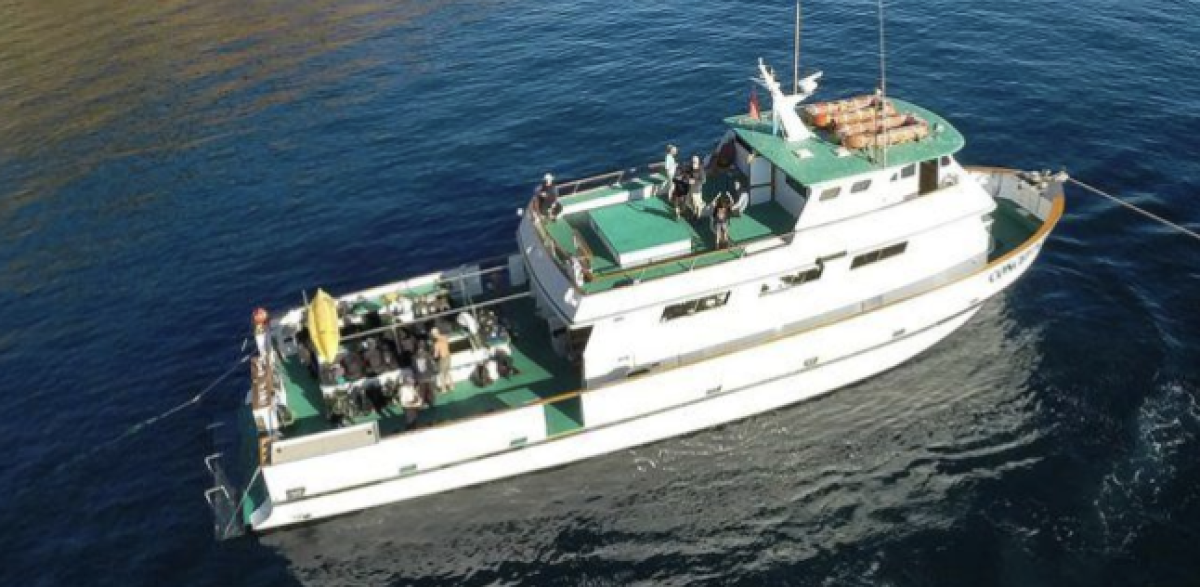
Wolfe, the retired fire captain who had traveled aboard the Conception a handful of times, said the bench on the boat with the outlets was not only a place to charge batteries and electronics.
“The space down behind the cushion often had T-shirts, towels and bottles of wine because it was a place to store them and stop them from rolling around,” said Wolfe, who wondered whether the cushions could have provided fuel for the blaze.
He also questioned why the vessel’s smoke detectors wouldn’t have been triggered by the fire, alerting the crew to the blaze sooner.
Investigators seek cause of deadly fire aboard California dive boat
The National Transportation Safety Board’s preliminary report found that the entire crew was asleep before the blaze was discovered and the Conception did not have a roaming watchman, as required by the U.S. Coast Guard for vessel certification.
Kurtis and others were stunned by the disaster in part because the boat owner, Truth Aquatics, has a strong reputation in the boating industry.
“Truth Aquatics was the last boat you think would burn,” he said. “The questions everyone is asking is: How did this fire start? And how and why did it spread so quickly?”
More to Read
Sign up for Essential California
The most important California stories and recommendations in your inbox every morning.
You may occasionally receive promotional content from the Los Angeles Times.

